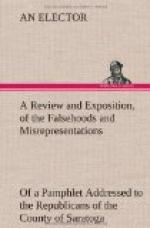Were Ireland to accept the bribe now offered she would indeed justify the reproach of Wilfred Blunt; but she would become some thing else than a “weapon of offence in England’s hands against the freedom of the world elsewhere;” she would share, and rightly share the fate of the parasite growth that, having gripped her trunk so tightly, has by that aid reached the sunlight. The British Empire is no northern oak tree. It is a creeping, climbing plant that has fastened on the limbs of others and grown great from a sap not its own. If we seek an analogy for it in the vegetable and not in the animal world we must go to the forests of the tropics and not to the northland woodlands. In the great swamps at the mouth of the Amazon the naturalist Bates describes a monstrous liana, the “Sipo Matador” or Murdering Creeper, that far more fitly than the oak tree of the north typifies John Bull and the place he has won in the sunlight by the once strong limbs of Ireland.
Speaking of the forests round Para, Bates says:—“In these tropical forests each plant and tree seems to be striving to outvie its fellows, struggling upwards towards light and air—branch and leaf and stem—regardless of its neighbours. Parasitic plants are seen fastening with firm grip on others, making use of them with reckless indifference as instruments for their own advancement. Live and let live is clearly not the maxim taught in these wildernesses. There is one kind of parasitic tree very common near Para which exhibits this feature in a very prominent manner. It is called the “Sipo Matador,” or Murderer Liana. It belongs to the fig order, and has been described and figured by Von Martius as the Atlas to Spix and Martius’ Travels. I observed many specimens. The base of its stem would be unable to bear the weight of the upper growth; it is obliged therefore to support itself on a tree of another species. In this it is not essentially different from other climbing trees and plants, but the way the Matador sets about it is peculiar and produces certainly a disagreeable impression. It springs up close to the tree on which it intends to fix itself, and the wood of its stem grows by spreading itself like a plastic mould over one side of the trunk of its supporter. It then puts forth, from each side, an armlike branch, which grows rapidly, and looks as though a stream of sap were flowing and hardening as it went. This adheres closely to the trunk of the victim, and the two arms meet at the opposite side and blend together. These arms are put forth at somewhat regular intervals in mounting upwards, and the victim, when its strangler is full grown, becomes tightly clasped by a number of inflexible rings. These rings gradually grow larger as the Murderer flourishes, rearing its crown of foliage to the sky mingled with that of its neighbour, and in course of time they kill it, by stopping the flow of its sap. The strange spectacle now remains of the selfish parasite clasping in its arms the lifeless and decaying body of its victim, which had been a help to its own growth. Its ends have been served—it has flowered and fruited, reproduced and disseminated its kind; and now when the dead trunk moulders away its own end approaches; its support is gone and itself also falls.”




